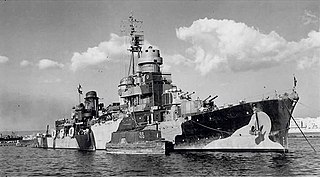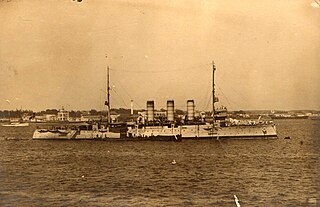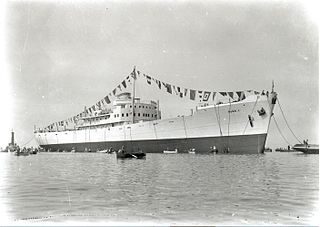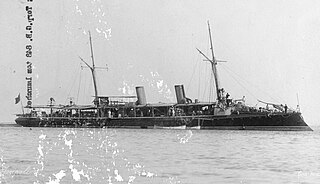 W
WSMS Graudenz was the lead ship of her class of light cruisers. She had one sister ship, SMS Regensburg. The ship was built by the German Kaiserliche Marine in the Kaiserliche Werft shipyard in Kiel, laid down in 1912 and commissioned into the High Seas Fleet in August 1914, days after the outbreak of World War I. She was named for the then-German town of Graudenz. The ship was armed with a main battery of twelve 10.5 cm SK L/45 guns and had a top speed of 27.5 knots.
 W
WSMS Pillau was a light cruiser of the Imperial German Navy. The ship, originally ordered in 1913 by the Russian navy under the name Maraviev Amurskyy, was launched in April 1914 at the Schichau-Werke shipyard in Danzig. However, due to the outbreak of World War I in August 1914, the incomplete ship was confiscated by Germany and renamed SMS Pillau for the East Prussian port of Pillau. The Pillau was commissioned into the German Navy in December 1914. She was armed with a main battery of eight 15 cm SK L/45 (5.9-inch) guns and had a top speed of 27.5 kn. One sister ship was built, Elbing.
 W
WThe Capitani Romani-class was a class of light cruisers acting as flotilla leaders for the Regia Marina. They were built to outrun and outgun the large new French destroyers of the Le Fantasque and Mogador classes. Twelve hulls were ordered in late 1939, but only four were completed, just three of these before the Italian armistice in 1943. The ships were named after prominent ancient Romans.
 W
WSMS Niobe was the second member of the ten-ship Gazelle class of light cruisers that were built for the German Kaiserliche Marine in the late 1890s and early 1900s. The Gazelle class was the culmination of earlier unprotected cruiser and aviso designs, combining the best aspects of both types in what became the progenitor of all future light cruisers of the Imperial fleet. Built to be able to serve with the main German fleet and as a colonial cruiser, she was armed with a battery of ten 10.5 cm (4.1 in) guns and a top speed of 21.5 knots. The ship had a long career, serving in all three German navies, along with the Yugoslav and Italian fleets over the span of more than forty years.
 W
WCesare Rossarol was a scout cruiser built in Sestri Ponente, Genoa, in 1913 and launched by S.A.I. Gio. Ansaldo & C. in Liguria, Italy, in 1914. Like her sister ships, Alessandro Poerio and Guglielmo Pepe, she was named after a famous Neapolitan light cavalryman who helped defend Venice from attacks by the Austro-Hungarian Army during the revolutions in 1848.
 W
WThe Condottieri class was a sequence of five different light cruiser classes of the Regia Marina, although these classes show a clear line of evolution. They were built before World War II to gain predominance in the Mediterranean Sea. The ships were named after condottieri of Italian history.
 W
WDogali was a unique protected cruiser built for the Italian Regia Marina in the 1880s. Notably, she was the first warship equipped with triple-expansion engines. The ship was originally ordered by the Greek Navy and named Salamis, but she was sold to the Regia Marina before she was completed and renamed for the Battle of Dogali. She was armed with a main battery of six 15-centimeter (5.9 in) guns and reached a speed of 19.66 knots on her sea trials, making her one of the fastest cruisers at the time.
 W
WEtna was a protected cruiser of the Italian Regia Marina built in the 1880s. She was the lead ship of the Etna class, which included three sister ships. Named for Mount Etna on the island of Sicily, the ship was laid down in January 1883, was launched in September 1885, and was completed in December 1887. She was armed with a main battery of two 10-inch (254 mm) and six 6-inch (152 mm) guns, and could steam at a speed of around 17 knots.
 W
WThe Etna class were two cruisers originally ordered in Italy for the Thai Navy in 1938 and subsequently requisitioned for service by the Italian Navy on the outbreak of World War II, neither ship was completed and the damaged hulls were scrapped after the war.
 W
WJean de Vienne was a French light cruiser of the La Galissonnière class. During World War II, she remained with Vichy France. She was named for Jean de Vienne, a 14th-century French knight, general and admiral during the Hundred Years' War.
 W
WLa Galissonnière was the lead ship of her class of six light cruisers built for the Marine Nationale during the 1930s. She was named in honour of Roland-Michel Barrin de La Galissonière. During World War II, she served with Vichy France.
 W
WSMS Graudenz was the lead ship of her class of light cruisers. She had one sister ship, SMS Regensburg. The ship was built by the German Kaiserliche Marine in the Kaiserliche Werft shipyard in Kiel, laid down in 1912 and commissioned into the High Seas Fleet in August 1914, days after the outbreak of World War I. She was named for the then-German town of Graudenz. The ship was armed with a main battery of twelve 10.5 cm SK L/45 guns and had a top speed of 27.5 knots.
 W
WLibia was a protected cruiser built in Italy in the 1900s. The ship had originally been laid down in 1907 for the Ottoman Navy and was to have been named Drama, and was based on the Ottoman cruiser Hamidiye. She had not been completed by the outbreak of the Italo-Turkish War in 1911 and so she was seized by the Italian Regia Marina and was completed in 1913. The ship was armed with two 152 mm (6 in) and eight 120 mm (4.7 in) guns, and was capable of a top speed of over 22 knots.
 W
WNMS Mărășești was one of four Vifor-class destroyers ordered by Romania shortly before the beginning of the First World War from Italy. All four sister ships were requisitioned when Italy joined the war in 1915. Originally named Vârtej by the Romanians, she was renamed Nibbio in Italian service. Not completed until mid-1918, the ship engaged Austro-Hungarian ships in the Adriatic Sea only once before the war ended in November. She was renamed Mărășești when she was re-purchased by the Romanians in 1920.
 W
WNMS Mărăști was one of four Vifor-class destroyers ordered by Romania shortly before the beginning of the First World War from Italy. All four sister ships were requisitioned when Italy joined the war in 1915. Originally named Vijelie by the Romanians, she was renamed Sparviero in Italian service. Not completed until mid-1917, the ship engaged Austro-Hungarian ships in the Adriatic Sea only twice before the war ended in November 1918. She was given a new name as Mărăști when she was re-purchased by the Romanians in 1920.
 W
WThe Vifor class was a group of four destroyers ordered by Romania in 1913 and built in Italy during the First World War. The four ships were however requisitioned by Italy in 1915 and rearmed as scout cruisers (esploratori), subsequently seeing service in World War I. Two were re-purchased by Romania in 1920 and saw service in World War II. The other two were eventually transferred by Italy to the Spanish Nationalists and saw service during the Spanish Civil War.
 W
WMarco Polo was an armored cruiser built for the Royal Italian Navy in the 1890s, the first of her type in Italian service. The ship spent the bulk of her career deployed in the Far East. Between deployments she participated in the Italo-Turkish War of 1911–12 during which she caused a diplomatic incident with the Austro-Hungarian Empire. After that affair Marco Polo was sent to Libya where she bombarded the towns of Homs, and Zuara and the defenses of the Dardanelles. In between these operations, the ship provided naval gunfire support to the Royal Italian Army in Libya. Due to her age, Marco Polo did not play a significant role in World War I, serving as an accommodation ship in Venice until she began conversion into a troopship in 1917. After a series of renamings in 1920–21, the ship was stricken from the naval register in 1922 and subsequently sold for scrap.
 W
WPiemonte was a unique protected cruiser built for the Italian Regia Marina in the 1880s by the British shipyard Armstrong Whitworth. She was the first major warship armed entirely with quick-firing (QF) guns and she was also the fastest cruiser in the world upon her completion in 1889. Piemonte was frequently deployed overseas, including a lengthy tour in East Asian waters from 1901 to 1904. She saw significant action during the Italo-Turkish War in 1911–12 in the Red Sea, where she frequently bombarded Ottoman ports. During the Battle of Kunfuda Bay in January 1912, she and two destroyers sank four Ottoman gunboats and forced ashore three more. Piemonte participated in World War I but she saw little action during the conflict. She remained in service until 1920, when she was scrapped.
 W
WPietro Micca was the first torpedo cruiser built by the Italian Regia Marina, and one of the first vessels of the type to built by any navy. She was laid down in February 1875, launched in August 1876, and completed in July 1877. Details of her armament are contradictory, with various sources reporting a range of torpedo weapons, including a single 16-inch (406 mm) torpedo tube, a pair of tubes of undetermined diameter, and as many as six tubes. She proved to be unable to reach the projected speed of 17 knots, and so she did not see much active service. She remained in the Regia Marina's inventory until 1893, but spent most of her 16-year life in the reserve.
 W
WSMS Pillau was a light cruiser of the Imperial German Navy. The ship, originally ordered in 1913 by the Russian navy under the name Maraviev Amurskyy, was launched in April 1914 at the Schichau-Werke shipyard in Danzig. However, due to the outbreak of World War I in August 1914, the incomplete ship was confiscated by Germany and renamed SMS Pillau for the East Prussian port of Pillau. The Pillau was commissioned into the German Navy in December 1914. She was armed with a main battery of eight 15 cm SK L/45 (5.9-inch) guns and had a top speed of 27.5 kn. One sister ship was built, Elbing.
 W
WThe Pisa class consisted of three armored cruisers built in Italy in the first decade of the 20th century. Two of these were for the Royal Italian Navy and the third was sold to the Royal Hellenic Navy and named Georgios Averof. This ship served as the Greek flagship for the bulk of her active career and participated in the Balkan Wars of 1912–1913, fighting in two battles against the Ottoman Navy. She played a minor role in World War II after escaping from Greece during the German invasion in early 1941. Influenced by communist agitators, her crew mutinied in 1944, but it was suppressed without any bloodshed. Georgios Averof returned to Greece after the German evacuation in late 1944 and became a museum ship in 1952. She is the only surviving armored cruiser in the world.
 W
WQuarto was a unique protected cruiser built by the Italian Regia Marina in the 1910s. Her keel was laid in November 1909, she was launched in August 1911, and was completed in March 1913. She was the first Italian cruiser to be equipped with steam turbines, which gave her a top speed of 28 knots. Her high speed was a requirement for the role in which she was designed to serve: a scout for the main Italian fleet.
 W
WThe Italian ship Ramb I was a pre-war "banana boat" converted to an auxiliary cruiser during World War II. Ramb I operated as an armed merchant in the Red Sea and was ordered to sail to Japan after the fall of Massawa to the Allies. She was sunk in the Indian Ocean before she could reach her intended destination.
 W
WThe Italian auxiliary cruiser Ramb II was a pre-war banana boat built at Monfalcone by the CRDA in 1937. She briefly served as an auxiliary cruiser with Regia Marina early in World War II before becoming an auxiliary transport with the Imperial Japanese Navy later in her career.
 W
WThe San Giorgio class consisted of two armored cruisers built for the Royal Italian Navy in the first decade of the 20th century. The second ship, San Marco, was used to evaluate recently invented steam turbines in a large ship and incorporated a number of other technological advances. The ships participated in the Italo-Turkish War of 1911–1912, although San Giorgio was under repair for most of the war. San Marco supported ground forces in Libya with naval gunfire and helped them to occupy towns in Libya and islands in the Dodecanese. During World War I, the ships' activities were limited by the threat of Austro-Hungarian submarines, although they did bombard Durazzo, Albania in 1918.
 W
WSMS Lussin was a torpedo cruiser of the Austro-Hungarian Navy, a modified version of the preceding Zara class. As envisaged by the Marinekommandant, Vice Admiral Friedrich von Pöck, Lussin would be the leader of a flotilla of torpedo boats, with the additional capability of carrying out scouting duties. The ship proved to be too slow and too lightly armed for either of these tasks, so she spent the majority of her career as a training ship for engine and boiler room personnel, along with occasional stints with the main fleet for training exercises. She took part in only one significant operation, an international blockade of Greece in 1886 to prevent the country from declaring war on the Ottoman Empire. In 1910–1913, Lussin was rebuilt as an admiralty yacht, and she spent World War I as a barracks ship for German U-boat crews based in Pola. After the war, she was ceded to Italy as a war prize, renamed Sorrento, and briefly saw service as a mother ship for MAS boats from 1924 to 1928, when she was discarded.
 W
WSMS Strassburg was a light cruiser of the Magdeburg class in the German Kaiserliche Marine. Her class included three other ships: Magdeburg, Breslau, and Stralsund. Strassburg was built at the Kaiserliche Werft shipyard in Wilhelmshaven from 1910 to October 1912, when she was commissioned into the High Seas Fleet. The ship was armed with a main battery of twelve 10.5 cm (4.1 in) SK L/45 guns and had a top speed of 27.5 knots.
 W
WTripoli was the first modern torpedo cruiser built for the Italian Regia Marina. She was built by the Regio Cantiere di Castellammare di Stabia shipyard in 1885–86. The only vessel of her class, she provided the basis for the Goito and Partenope classes that followed. She was armed with five 14-inch (356 mm) torpedo tubes and a battery of light guns, and was capable of a top speed of 17.5 knots. Tripoli spent her career in the main Italian fleet, where she was occupied primarily with peacetime training exercises. She was modernized several times throughout her career, and in 1910, was converted into a minelayer, a role she served in for another thirteen years, including during World War I. She was the longest serving torpedo cruiser in the Italian fleet, with over 36 years in service by the time she was discarded in March 1923.
 W
WThe Vettor Pisani class consisted of two armoured cruisers built for the Royal Italian Navy in the 1890s. The two ships of the class, Vettor Pisani and Carlo Alberto, were frequently deployed overseas during their careers. The former served in the Far East during the Boxer Rebellion of 1900 while the latter was involved in pioneering long-range radio experiments several years later before deploying to South American waters. Carlo Alberto then served as a training ship for several years. Both ships participated in the Italo-Turkish War of 1911–12 and played minor roles in World War I, during which time Carlo Alberto was converted into a troop transport and Vettor Pisani into a repair ship. They were both discarded in 1920 and subsequently scrapped.